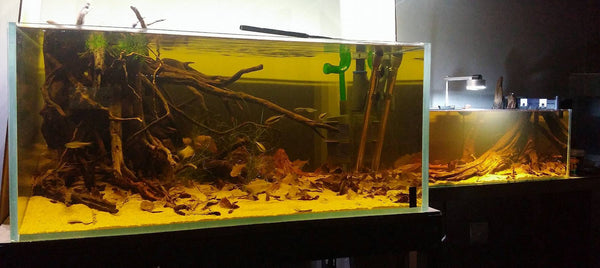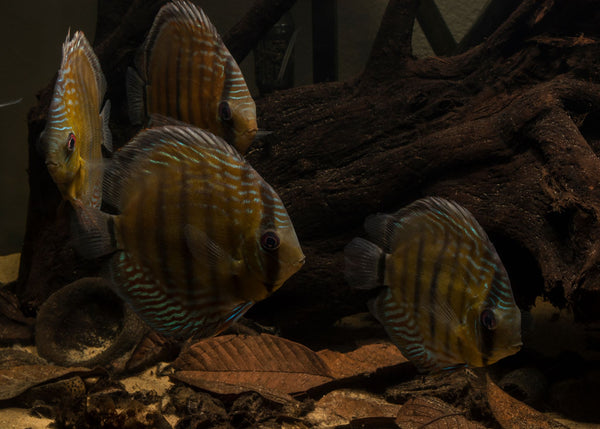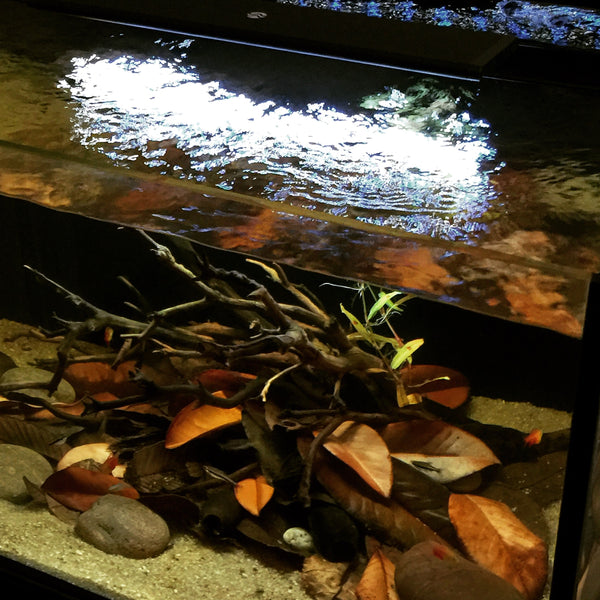- Continue Shopping
- Your Cart is Empty
Getting in on the action...the basics of working with leaves in your aquarium...

Okay, you've seen the pics of all the cool tanks. You've heard the buzz all over social media. Seems like more and more people are talking about blackwater aquariums, botanicals, and real "natural-style" aquariums...

And you want in on the action.
Hey, who could blame you? This stuff is kind of cool!
However, how do you start? How do you choose which botanicals to play with?
That's a question that is kind of difficult for me to even answer...What I'd usually tell you when asked is, "It depends." (extremely helpful, I know...)
We can hit on this topic in future installments. Today, let's touch on the use of leaves in the aquarium; typically, leaves are the "jumping off point" for a lot of hobbyists as they start their botanical-style/blackwater aquarium experience, and it makes sense to touch on them first!
If your goal is to add some leaf litter to supplement your hardscape or to become the primary focus of your aquascape, then you have a wide variety of leaves from which to choose, some of which we offer here at Tannin. We've written extensively about how you can collect and experiment with fallen leaves from other trees, so I won't get into that here. Rather, let's stick to the leaves you see on our site and in aquariums worldwide.
Of course, there are what I call the "Big 5" leaves we play with in the botanical aquarium world: Catappa, Guava, Loquat, Jackfruit, and Magnolia. Again, there are many other leaves that hobbyists play with from time to time; however, we've found that these particular leaves tend to be the most useful and versatile leaves, each with their own characteristics, appearance, and benefits.
What are my faves? Well, personally, although Catappa is the sentimental favorite, because of its versatility and "obtainability", my personal favorite has to be Guava, followed by Magnolia. Why? Well, Guava just look exotic to me! They have a beautiful shape and structure, and they last a long, long time submerged- often two or more months-before decomposing away! They impart a lighter "tint" to the water, yet offer that exotic aesthetic which makes up for their lesser amount of tannin-imparting capability.
Magnolia, on the other hand, will put out a pretty good "tint" into the water, lasts for 2-3 months, sometimes more- and have beautiful shape and color. They tent to recruit more biofilms than many other leaves, because of their waxy cutin dermal layer. The very thing that makes them last so long under water also enables them to recruit more biofilm.

When I'm asked which of these leaves last the longest when submerged, I must start by telling you that, although many leaves have different durability and tannin-imparting capabilities, your specific water chemistry, fish population, etc. are the major determining factors in how long a given leaf will last submerged in your aquarium.
In order of "longevity", from least durable to most durable, I'd say it goes something like this:
*Catappa
*Loquat
*Jackfruit
*Guava
*Magnolia
And then there are those "leaf surrogates" or "leaf substitutes"- botanicals which look sort of "leaf-like", are heavier in weight and structure, and may be used to create a longer-lasting component of a good leaf litter bed. At this point, I'm sure that this piece might take on a bit of an "infomercial" flavor, because I'm mentioning some of the stuff we offer, but it's kind of unavoidable, so...here goes.
Terra Sorrindo- These are palm-derived botanicals, and look sort of like a brown potato chip. They last a really long time and look perfect when mixed into the "softer-looking" leaves like Catappa and Guava.
"Mariposa Pods"/"Mini Mariposa Pods"- Another palm-derived botanical that mixes nicely with leaves. These are lighter weight, last virtually indefinitely, and will impart a fair amount of orange-brown color into the water.

"Encontro Pods"- These botanicals look like a thick, "beefy" leaf, and are perfect to use as "anchor pieces"- literally and figuratively- in your litter bed to hold down lightweight leaves, provide some nice accent, and impart a little bit of tint to the water. They tend to recruit a bit of biofilm at first, so be patient with them!
Any combination of these leaves and botanicals would help you create a really cool, aesthetically attractive, yet "functional" leaf litter bed. You can supplement/replace with new leaves as the old ones decompose, so it's never a bad idea to keep some extras on hand! (heh, heh, heh...)
As far as preparation- you do know that we have the preparation instructions for every botanical we offer on a dedicated page on our website, right? That being said, the preparation of leaves is one of the few "controversies" in the botanical aquarium world. Yeah. I'm the very conservative type, and as a responsible aquarist/business owner, I recommend steeping your leaves in boiling water for a few minutes to soften them, and then soak over night in room temperature water before use.
The steep will help break down the tissues a bit to facilitate sinking, eliminate any surface contaminants, and help release some of the remaining sugars and initial tannins bound up in the leaf tissue. Of course, everyone asks if you're eliminating all of the beneficial tannins when you do this. My answer: No. You re not. They will keep leaching out tannins for quite some time, even after this comprehensive prep process.
Everyone has a different opinion on this; that's just mine. Lately, I admit I've forgone the boiling water in favor of a room-temperature overnight soak, or sometimes, just a heavy rinse in tap water, and then added the leaves to my aquariums. Ive encountered no problems, other than a slightly higher "buoyancy" with the non-steeped leaves. Some people might say they last longer, too. Your call.
As far as "placement" and "depth of litter bed" is concerned, that's really up to you. I've gone over the possible issues with adding a proportionately large influx of fresh leaves and botanicals to an established aquarium at once, and I stand by my recommendation to go slowly. As you are aware, rapidly adding a bunch of leaves that will contribute to the bioload of the aquarium, not to mention, potentially decrease the pH, can have some serious consequences for the animals in your system.
Besides, part of the fun is watching the aquarium "evolve" over time. Test pH, ammonia, and nitrite regularly during the first few days after you've added the botanicals to an existing tank, and perhaps pH and nitrate/phosphate on the longer term, to establish "baseline" parameters and monitor any trends as your system matures. "Test, then tweak" is a favorite old aquarium adage of mine for a good reason.

Patience.
Depth-wise, it's your call, and wide open for experimentation. In a properly filtered, well-maintained aquarium, I see little reason why you couldn't create a very deep litter bed, approaching 8-10 inches (20.32-25.4 cm) deep- or more! In nature, leaf litter beds may be several meters deep!

Now, I realize that an aquarium is not an open-system like a stream, and that there are upper limits to what you can do, so the real takeaway here is that, with careful experimentation, observation, and a willingness to make "mid-course corrections", you as the hobbyist can try all sorts of things with regards to depth and composition of your leaf litter bed.
Bonus questions?
Hmm, how about what to do about the moldy spots you sometimes see on leaves? This is particularly common with Catappa, Jackfruit, and Magnolia. It happens somewhere along the line, during the chain of preparation by the collectors, packaging, and transport. Magnolia, in particular tends to have more surface mold than most other leaves, in my experience, and I believe it's because the waxy cutin layer on these leaves retains more moisture than other leaves, and in a sealed plastic bag, they tend to release it and the resulting moist "environment" in the bag tends to recruit some mold on the surfaces of the leaves. I've never, ever had any problems by using leaves which have had mold on them in my aquariums. Because I take the time to prepare my leaves before using them, it's always been a "non-issue" in my experience. Just use some common sense. If the leaf is just covered in scuzzy mold, dump it. With a little "dusting" of mold, clean it and prepare as recommended before using in your aquarium.
A lot of hobbyists ask us which leaf they should use to simulate a habitat from such-and-such a locale. It's a logical question, and one which super hardcore biotope enthusiasts might rightly grapple with. My answer? Since most of the leaves we offer are found in multiple locations around the world, and some are not even tropical (like Magnolia leaves and Loquat leaves), the best we're doing is creating a reasonable facsimile of what's found in say, the Borneo Jungle or Amazonian rain forest. Rest assured, I'm diligently working my suppliers around the world for more varieties of leaves, particularly those from some exotic locales, and we'll have them really soon. However, for now, just understand that the leaves you have available will work just fine.

In fact, I don't think your fishes will notice one bit. Perhaps in the future, we will recognize some specific microfauna and such from leaves found in very specific locales, and how they impact the aquatic environment and its inhabitants, but for now, we're content (?) to replicate it on a more "superficial" level. Besides, once the water "tints" and the leaves start breaking down, unless you're really uptight, you won't be all that concerned about your Amazonian-themed tank having an Indian Jackfruit leaf in it. Trust me. Just enjoy it.
And of course, the most popular question about leaves that we receive has to be, "Should I leave them in or remove them as they break down?" You probably know my opinion by now, as I've written about it dozens of times before: I leave them in to completely break down, and only remove them if the debris is getting in the way of plant growth or causing some other nuisance in the aquarium. The aesthetic of decomposing leaves- not to mention, the impact of them, is something I've come to enjoy as one of the "core experiences" of a blackwater, botanical-style aquarium. Competition 'scapers and those who haven't really researched leaf litter beds call this horrifyingly undisciplined and "messy." I call it a REAL "nature aquarium."
Okay, I think we've just about covered the initial ins-and-outs of working with leaves in your aquarium. Sure, we could probably go on and on and on about water chemistry impact, tuning your aquarium for optimal performance with leaf litter, husbandry, etc., etc., but I think this is a good start. Our collective experiences and subsequent discussions will only add to the growing body of knowledge about the concept, aesthetics, function, husbandry, and long-term dynamics of the botanical-stye, blackwater aquarium. That's where YOU come in!

Stay excited. Stay curious. Stay disciplined. Stay adventurous.
And Stay Wet.
Scott Fellman
Tannin Aquatics






















Scott Fellman
Author